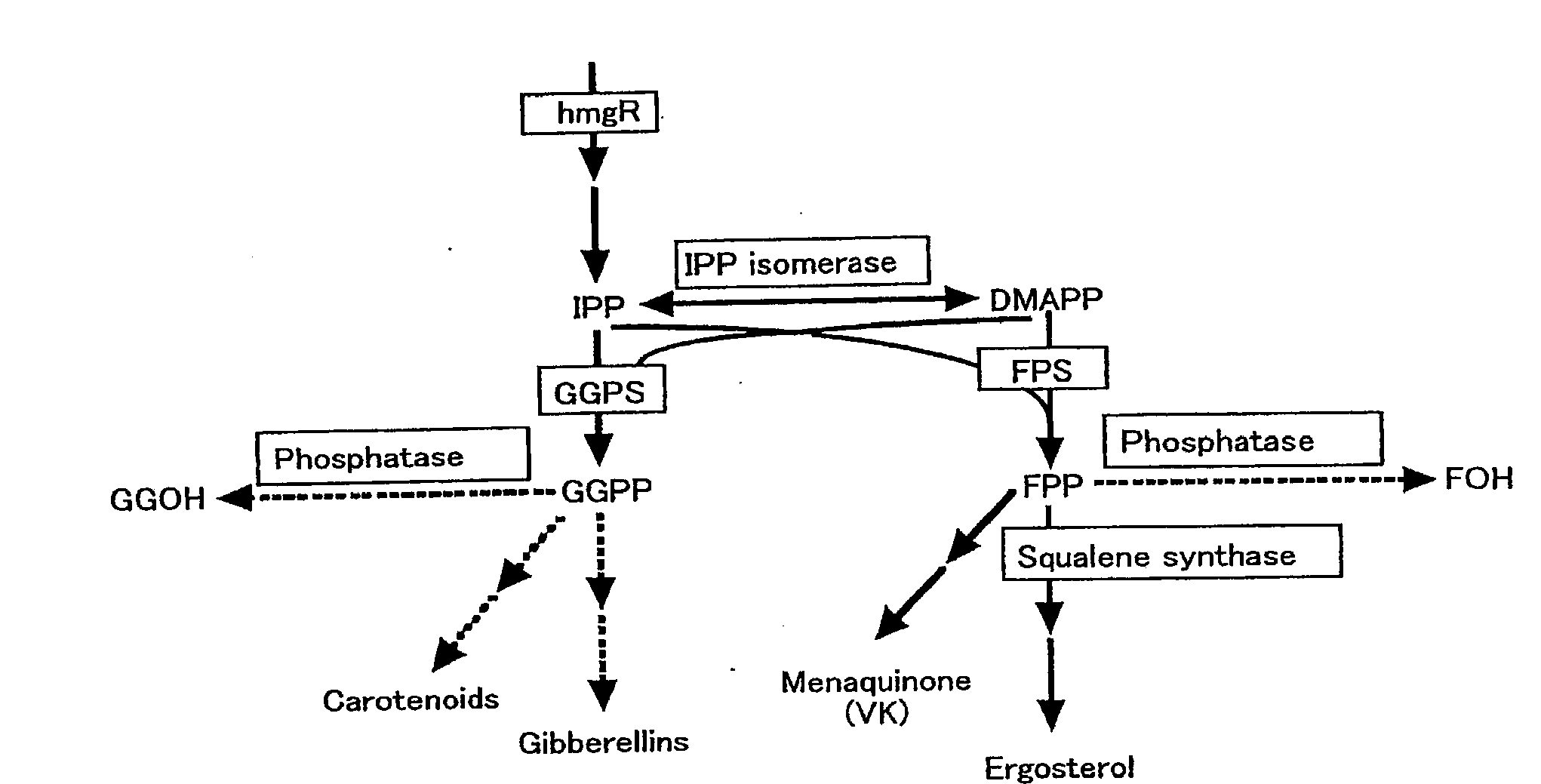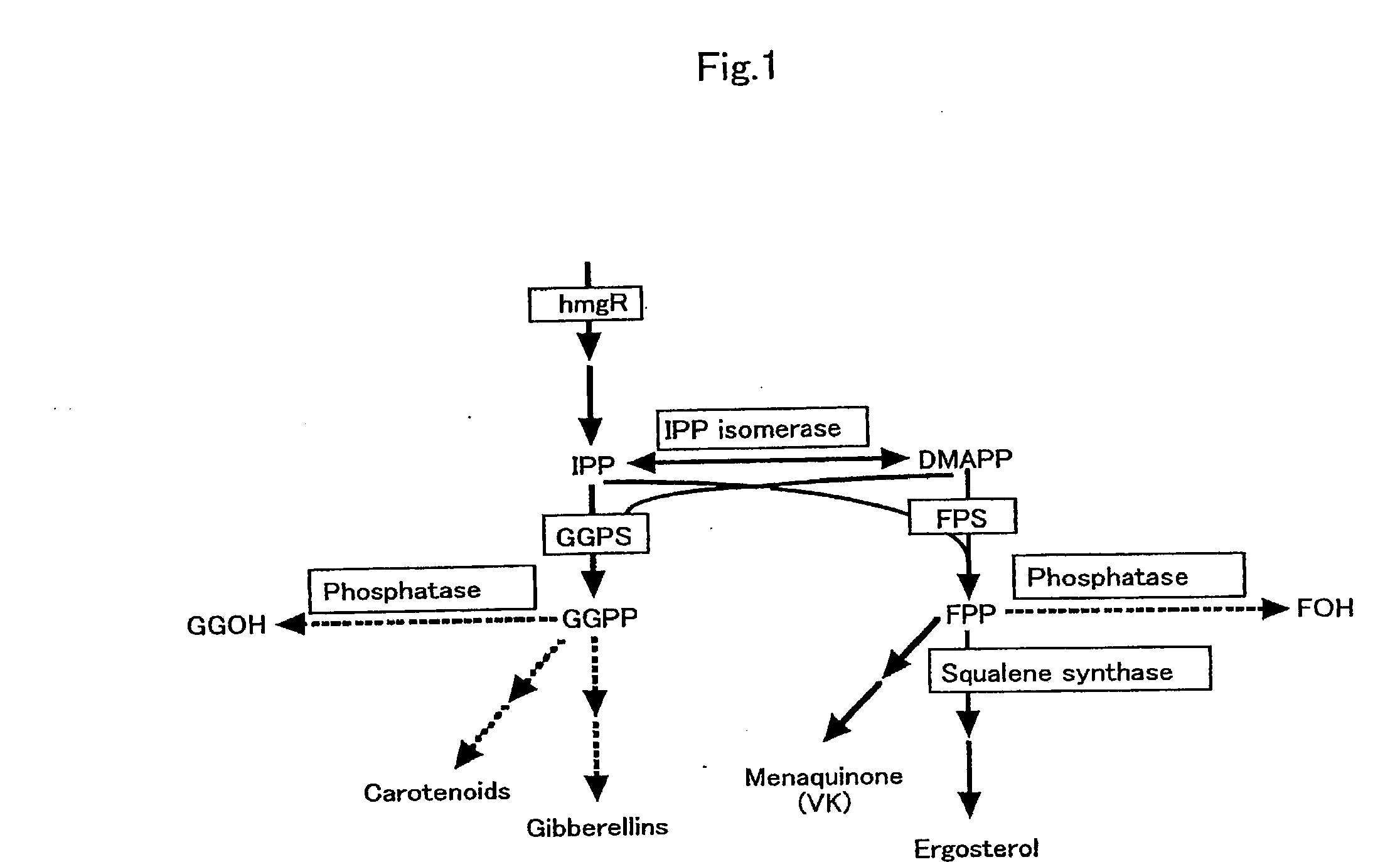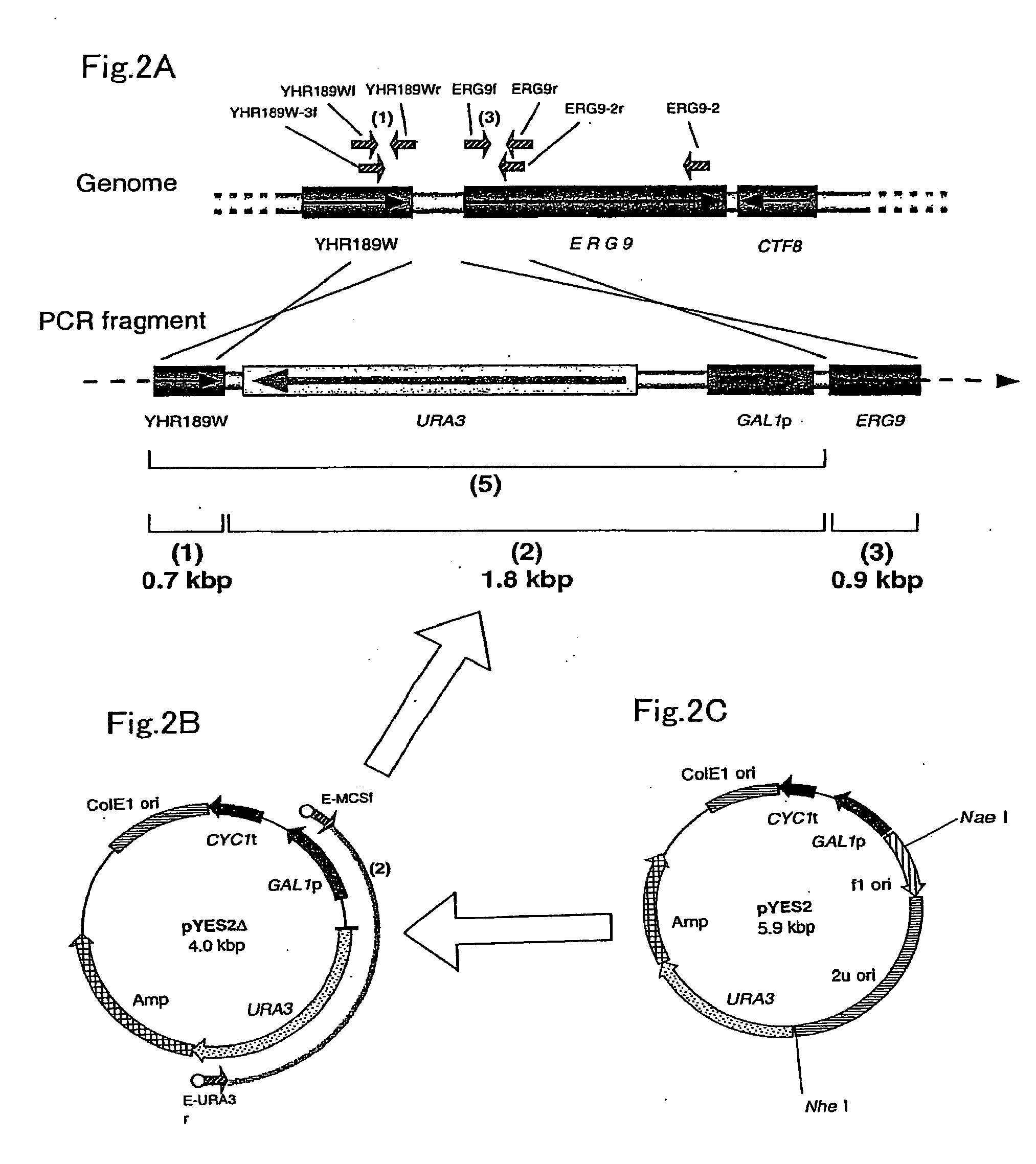Process for producing prenyl alcohols
a prenyl alcohol and process technology, applied in the direction of enzymology, peptides, transferases, etc., can solve the problems of high cost, inconvenient column chromatography refining of these substances, and difficulty in high-precision distillation of foh, a thermolable allyl alcohol, or its isomer foh, or ggoh
- Summary
- Abstract
- Description
- Claims
- Application Information
AI Technical Summary
Benefits of technology
Problems solved by technology
Method used
Image
Examples
example 1
Preparation of EUG Strains
[0203]A gene map around squalene synthase gene ERG9 was obtained from SGD. Based on this map, PCR primer DNAs for amplifying DNA fragments for replacing ERG9 transcription promoter (ERG9p) were designed (FIG. 2). On the other hand, a 1.8 kbp DNA fragment (FIG. 2A, (2)) comprising a transformant selection marker gene URA3 and a transcription promoter GAL1p was prepared by PCR amplification using, as a template, pYES2Δ (FIG. 2B) obtained by digesting pYES2 (FIG. 2C) with NaeI and NheI, blunt-ending with Klenow enzyme and deleting 2μ ori by self-ligation.
[0204]The primers used in the PCR are as follows.
E-MCSf:(SEQ ID NO: 34)5′-GCC GTT GAC AGA GGG TCC GAG CTC GGT ACC AAG-3′E-URA3r:(SEQ ID NO: 35)5′-CAT ACT GAC CCA TTG TCA ATG GGT AAT AAC TGAT-3′
[0205]In each of the above primers, an Eam1105I recognition site (the underlined portion) was added so that a 0.7 kbp DNA fragment comprising a downstream portion of the open reading frame YHR189W in the genome of S. cer...
example 2
Production of Prenyl Alcohols by Individual EUG Strains
(1) Determination of Prenyl Alcohol Yields: Part I
(1-1) Cultivation
[0212]EUG8, EUG12 and EUG27 were precultured in SGR-U medium, and 0.3 ml of each preculture broth was added to 30 ml of YM7 medium, YME medium or YM7 (Gal) medium. Then, each strain was cultured under reciprocal shaking at 130 rpm in a 300 ml Erlenmeyer flask at 30° C. YM7 medium refers to YM medium whose pH is adjusted to 7 with NaOH. YME medium refers to YM7 medium to which 50 mg / L of ergosterol is added. Specifically, this medium is prepared by adding 1 / 1000 volume of an ergosterol stock solution in ethanol-Tergitol (50 mg / ml) to YM7 medium. YM7 (Gal) medium refers to YM7 medium where its glucose component is replaced with galactose.
[0213]A 2.5 ml sample of the culture broth was taken out on day 1, 2, 3, 4, 7, 8 and 9 of the cultivation and subjected to determination of prenyl alcohol yields. Briefly, 2.5 ml of methanol was added to each sample and mixed. Abou...
example 3
Construction of Expression Vectors
[0248](1) E. coli-S. cerevisiae Shuttle Vectors
[0249]Plasmids pRS404 and pRS405 were purchased from Stratagene. Plasmid pYES2 (FIG. 3) was purchased from Invitrogen (Carlsbad, Calif.).
(2) Genomic DNA
[0250]Genomic DNA was prepared from S. cerevisiae YPH499 according to the protocol attached to Dr. GenTLE™, a genomic DNA preparation kit for yeast purchased from Takara.
[0251]Plasmid DNA from E. coli was prepared with Wizard PureFection Plasmid DNA Purification System purchased from Promega (Madison, Wis.).
(3) Insertion of CYC1t Fragment into pRS Vectors
[0252]CYC1t (CYC1 transcription terminator) fragment was prepared by PCR. The following oligo-DNAs, XhoI-Tcyc1FW and ApaI-Tcyc1RV, were used as PCR primers. As a template, pYES2 was used.
XhoI-Tcyc1FW:(SEQ ID NO: 43)5′-TGC ATC TCG AGG GCC GCA TCA TGT AAT TAG-3′ApaI-Tcyc1RV:(SEQ ID NO: 44)5′-CAT TAG GGC CCG GCC GCA AAT TAA AGC CTT CG-3′
[0253]Briefly, 50 μl of a reaction solution containing 0.1 μg of pYES2,...
PUM
 Login to View More
Login to View More Abstract
Description
Claims
Application Information
 Login to View More
Login to View More - R&D
- Intellectual Property
- Life Sciences
- Materials
- Tech Scout
- Unparalleled Data Quality
- Higher Quality Content
- 60% Fewer Hallucinations
Browse by: Latest US Patents, China's latest patents, Technical Efficacy Thesaurus, Application Domain, Technology Topic, Popular Technical Reports.
© 2025 PatSnap. All rights reserved.Legal|Privacy policy|Modern Slavery Act Transparency Statement|Sitemap|About US| Contact US: help@patsnap.com



